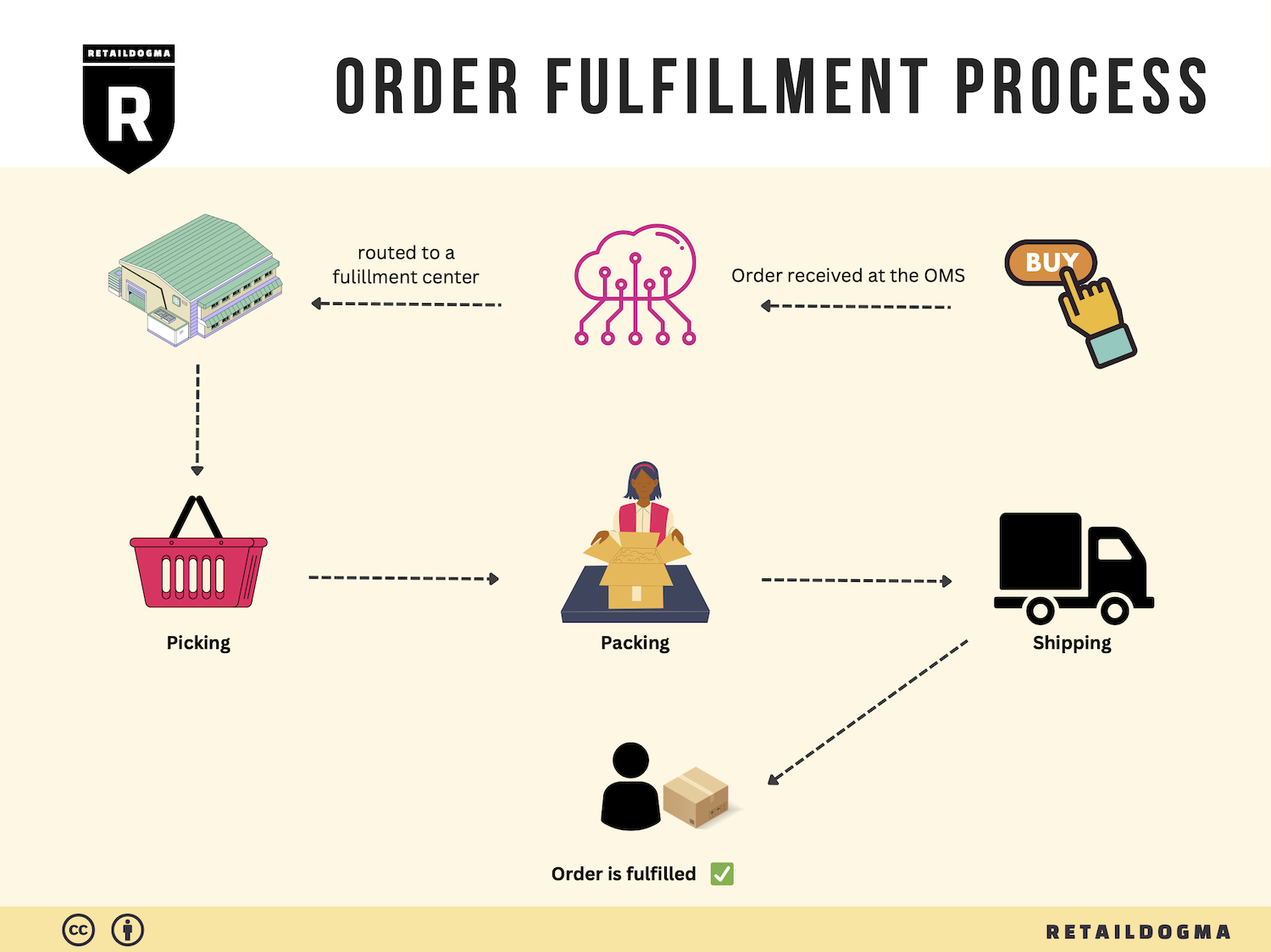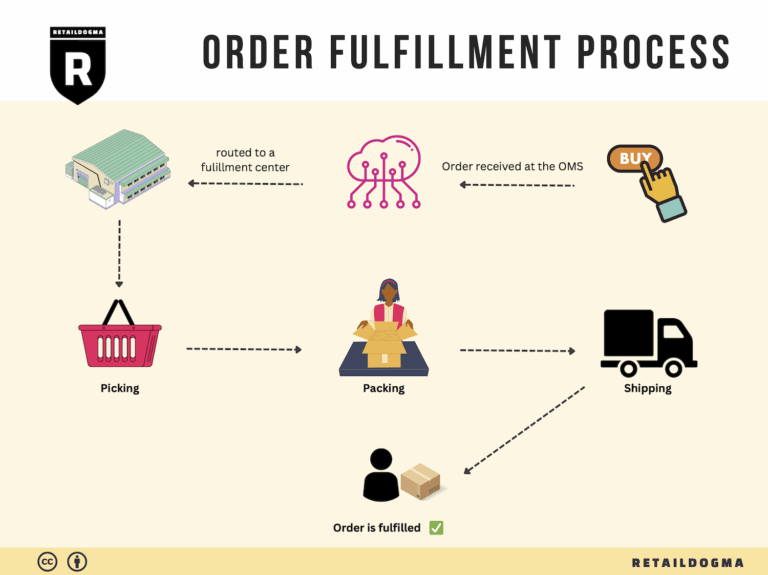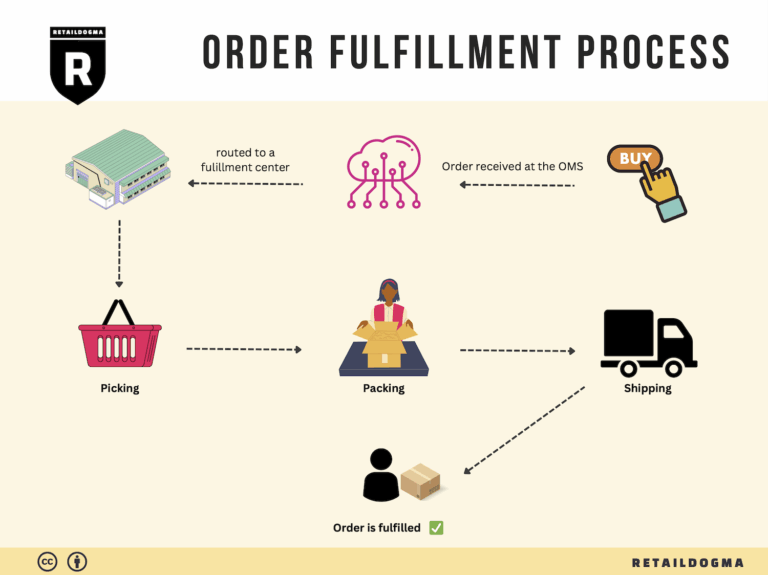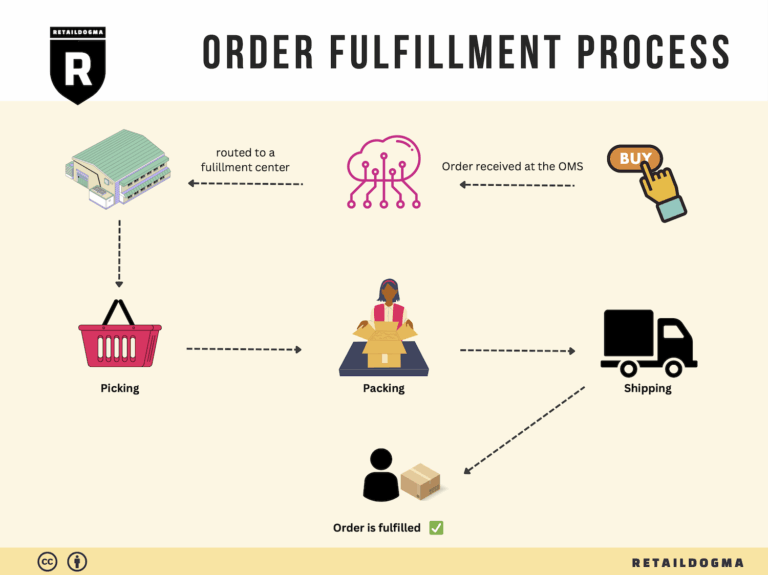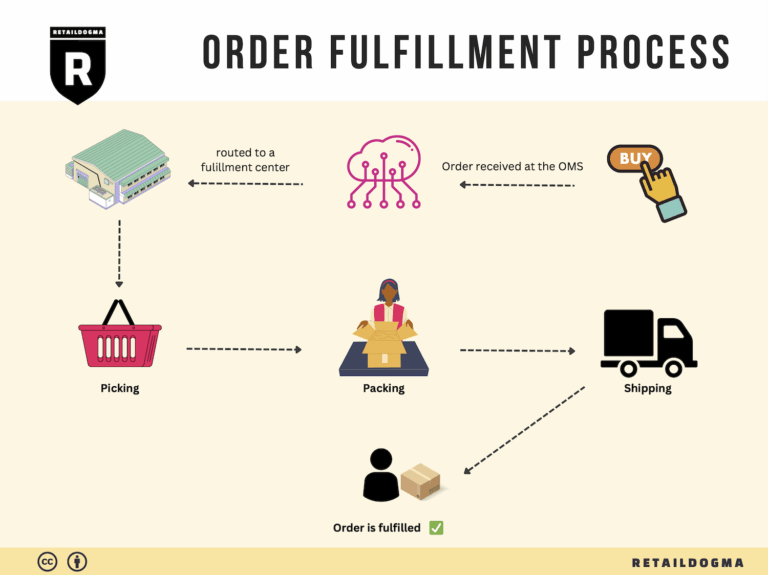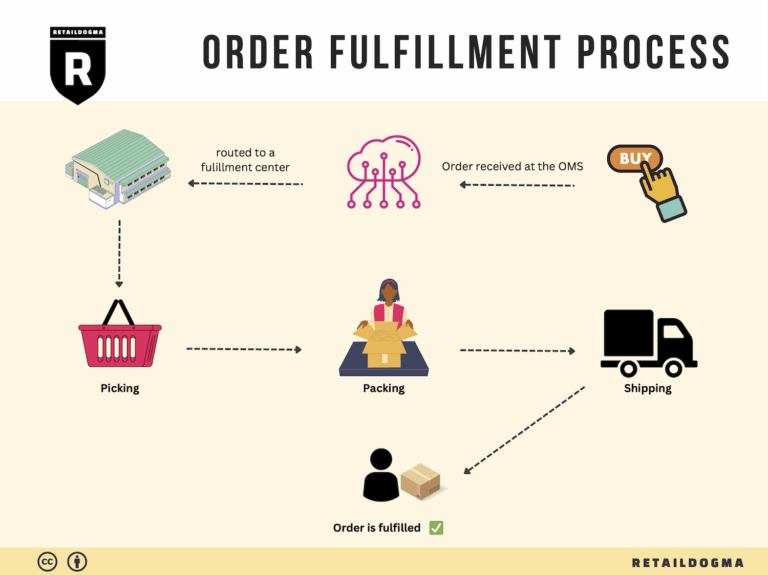How Order Fulfillment Works: A Step-by-Step Guide for Businesses
What is E-commerce Fulfillment? An Introduction for Growing Businesses
Understanding E-commerce Fulfillment
For many growing e-commerce businesses, the excitement of scaling sales often comes with the daunting challenge of logistics. As orders increase, so too does the complexity of packing and shipping them efficiently. This can lead to feelings of being overwhelmed, especially when trying to maintain a high level of customer satisfaction. Fulfillment, in its simplest form, is the process of getting a product from your warehouse or supplier to the customer’s doorstep. It encompasses everything from inventory management to shipping logistics.
In this guide, we will explore the various models of e-commerce fulfillment, including Fulfillment by Amazon (FBA) and third-party logistics (3PL). Each model has its advantages and considerations, allowing you to choose the best fit for your business needs. We will also delve into core fulfillment services such as inventory management, order processing, and shipping options. Understanding these services is crucial for optimizing your supply chain and improving overall efficiency.
Choosing the right fulfillment partner can significantly impact your business’s success. We will provide insights on what to look for in a fulfillment provider, including their technology capabilities, service offerings, and geographical reach. This information will help you make informed decisions that align with your business goals.
Cost is another critical factor in fulfillment. This guide will outline the pricing structures you can expect from various fulfillment options, helping you budget effectively and avoid unexpected expenses. By grasping the financial implications of your fulfillment choices, you can make strategic decisions that support your growth.
Ultimately, the goal of this guide is to empower e-commerce business owners, operations managers, and entrepreneurs to navigate the complexities of logistics with confidence. By understanding the ins and outs of e-commerce fulfillment, you will be better equipped to scale your operations, enhance customer satisfaction, and drive growth in your online business. Whether you’re just starting or looking to refine your processes, this guide serves as a comprehensive resource for making smart, informed decisions about your logistics strategy.
What You’ll Learn In This Guide
- What is E-commerce Fulfillment? An Introduction for Growing Businesses
- The Order Fulfillment Process: From ‘Buy’ Button to Customer’s Door
- Comparing Fulfillment Models: In-House vs. 3PL vs. Dropshipping
- A Deep Dive into Amazon FBA: Pros, Cons, and Who It’s For
- Core Services Offered by Fulfillment Centers
- How to Choose a Fulfillment Partner: A 6-Point Checklist
- Understanding Fulfillment Pricing: A Breakdown of Common Fees
- Frequently Asked Questions (FAQs) about Fulfillment
- Conclusion: Is Outsourcing Fulfillment the Right Move for Your Business?
- Important Disclaimer
The Order Fulfillment Process: From ‘Buy’ Button to Customer’s Door
1. Receiving Inventory
The order fulfillment process begins with receiving inventory at the fulfillment center. When products arrive, they are checked against purchase orders to ensure accuracy in quantity and quality. This step is crucial for maintaining inventory integrity and avoiding discrepancies that could affect future orders. The key term associated with this step is SKU (Stock Keeping Unit), a unique identifier assigned to each product, which helps streamline tracking and management.
Upon receiving the inventory, it is inspected for damages and counted to verify that it matches the order specifications. This ensures that only quality products are added to the inventory. Efficient receiving processes minimize delays in getting products into storage and ready for order fulfillment, which is essential for maintaining customer satisfaction and operational efficiency.
2. Warehouse Storage
Once inventory is received and verified, it is moved to warehouse storage. This step involves organizing products in a manner that maximizes space and facilitates quick retrieval. Proper warehousing strategies are vital as they directly influence the speed of order fulfillment. The associated key term here is bin locations, which refers to specific spots within the warehouse where products are stored.
Effective warehouse storage involves categorizing products based on factors such as size, demand frequency, and product type. This organization allows for easy navigation and helps warehouse staff locate items swiftly when orders come in. By optimizing storage solutions, businesses can reduce the time spent searching for products, thus enhancing overall operational efficiency.
3. Order Picking
The next step in the fulfillment process is order picking, where staff retrieve items from their designated storage locations based on customer orders. This step is critical because the accuracy and speed of picking directly impact customer satisfaction and fulfillment speed. The key term associated with this step is pick lists, which are documents or digital records detailing the items and quantities needed for each order.
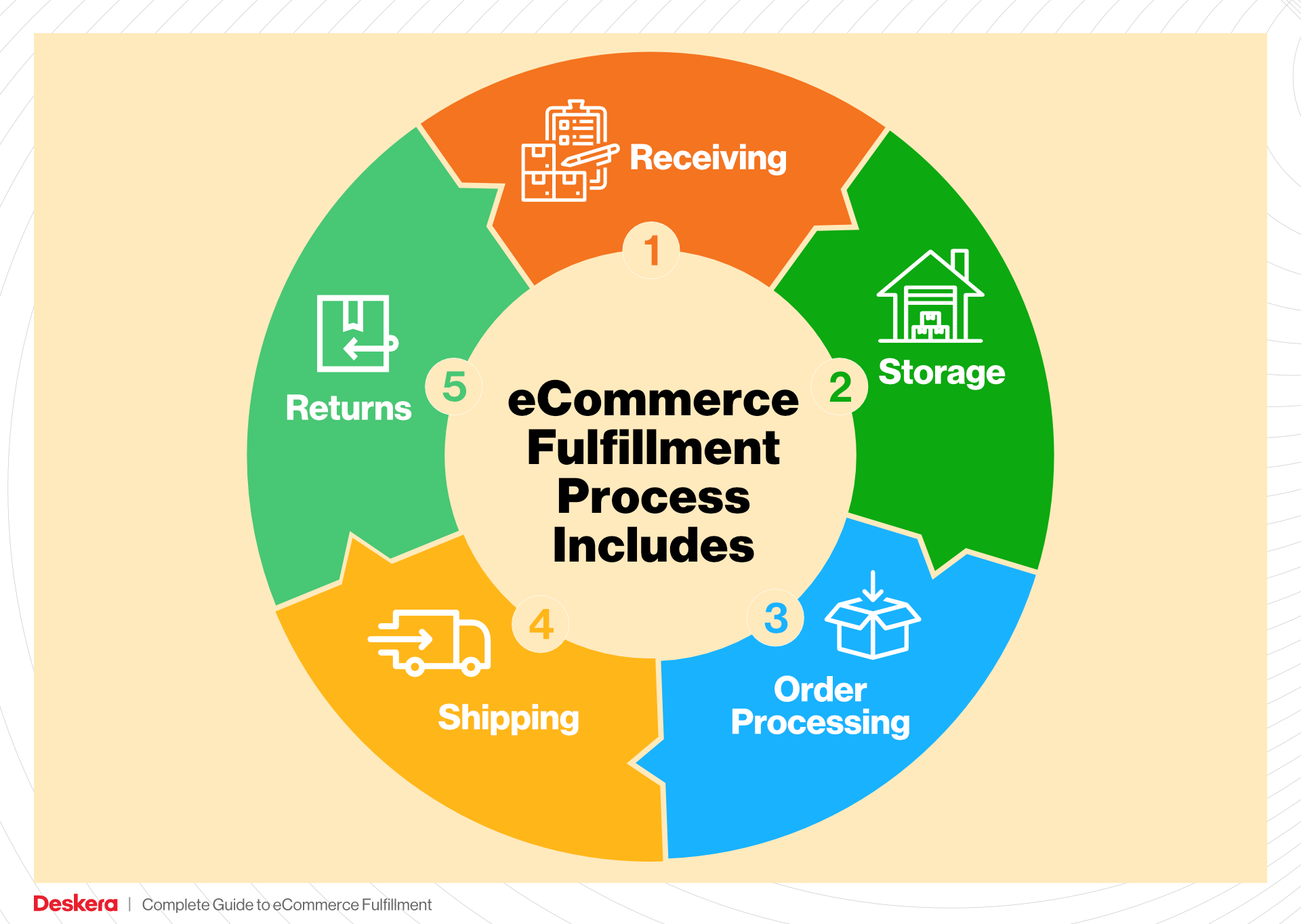
There are various picking methods, such as single order picking, batch picking, or zone picking, each suited for different types of operations. Implementing an efficient picking strategy can reduce labor costs and improve accuracy, ensuring that customers receive the correct items promptly. Automation technologies, such as barcode scanners and conveyor systems, can further streamline this process, minimizing human error and enhancing productivity.
4. Order Packing
After items are picked, they move to the order packing stage. This step involves securely packaging the products for shipment, ensuring they arrive at the customer’s door in perfect condition. The importance of this step cannot be overstated, as inadequate packing can lead to damages during transit, resulting in returns and dissatisfied customers. The key term here is packaging materials, which include boxes, cushioning, and tape used to protect the items.
Efficient packing processes consider factors such as product fragility, size, and weight to select appropriate materials. Additionally, branding can be incorporated into the packaging to enhance customer experience. Effective order packing not only protects items but also provides an opportunity for businesses to reinforce their brand image through thoughtful presentation.
5. Shipping & Delivery
The final step in the order fulfillment process is shipping and delivery. Once orders are packed, they are labeled and dispatched to the appropriate shipping carriers. This step is crucial as it determines how quickly customers receive their orders, impacting overall satisfaction and repeat business. The key term for this stage is last-mile delivery, which refers to the final leg of the delivery journey from the distribution center to the customer’s doorstep.
Selecting the right shipping partners and services is vital for efficient delivery. Businesses must consider factors such as cost, speed, and reliability when choosing carriers. Implementing tracking systems can also enhance transparency, allowing customers to monitor their order status. A streamlined shipping process ensures that products reach customers promptly, solidifying a company’s reputation for reliability and efficiency in the competitive e-commerce landscape.

By following these five steps—receiving inventory, warehouse storage, order picking, order packing, and shipping & delivery—e-commerce businesses can create an efficient order fulfillment process that meets customer expectations and scales effectively as demand grows.
Comparing Fulfillment Models: In-House vs. 3PL vs. Dropshipping
Fulfillment Models Comparison
| Model | Who Handles Inventory | Best For (Business Stage) | Key Advantage | Key Disadvantage |
|---|---|---|---|---|
| In-House Fulfillment | The business itself | Established businesses | Full control over inventory and operations | High overhead costs and operational complexity |
| Third-Party Logistics (3PL) | A third-party provider | Growing and scaling businesses | Cost-effective and scalable solutions | Less control over inventory and fulfillment speed |
| Dropshipping | Supplier/vendor | Startups and small businesses | Minimal upfront investment and low risk | Low margins and potential quality control issues |
In-House Fulfillment
In-house fulfillment refers to the process where a business manages its inventory and order fulfillment entirely within its own facilities. This model is often favored by established businesses that have the resources and operational capacity to handle logistics. The primary advantage of in-house fulfillment is the control it provides. Businesses can manage inventory levels, shipping times, and customer service processes directly, which can lead to improved customer satisfaction and loyalty. Additionally, businesses can implement personalized packing and branding strategies that resonate with their target audience.
However, this model comes with significant drawbacks. The costs associated with maintaining warehouse space, hiring staff, and managing logistics can be substantial. Furthermore, as order volumes grow, the complexity of operations can lead to inefficiencies and errors. Established businesses must weigh these costs against the benefits of control, particularly as they scale and seek to optimize their supply chain.
Third-Party Logistics (3PL)
Third-party logistics (3PL) involves outsourcing logistics and fulfillment operations to a specialized provider. This model is particularly advantageous for growing businesses that are looking to scale without the burden of managing their own logistics. A 3PL provider typically handles warehousing, inventory management, order processing, and shipping, allowing businesses to focus on core activities such as marketing and product development.
One of the key advantages of using a 3PL is cost-effectiveness. By leveraging a provider’s existing infrastructure, businesses can avoid the high costs associated with in-house fulfillment. Additionally, 3PLs often have established relationships with carriers, enabling better shipping rates and faster delivery options. However, businesses must be cautious about the potential downsides of this model. Relying on a third party can result in less control over inventory and fulfillment processes, which can lead to inconsistencies in service quality and customer experience. It’s crucial for businesses to choose a reputable 3PL that aligns with their operational needs and service standards.
Dropshipping
Dropshipping is a fulfillment model where the retailer does not hold inventory but instead purchases items from a third-party supplier who ships directly to the customer. This model is particularly appealing to startups and small businesses due to its low upfront investment and minimal financial risk. With dropshipping, entrepreneurs can test new products and markets without the burden of inventory management, making it an attractive option for those just starting out.

The primary advantage of dropshipping is its flexibility. Retailers can offer a wide range of products without the need for substantial capital investment in inventory. Additionally, the operational simplicity allows business owners to focus on marketing and sales rather than logistics. However, dropshipping is not without its challenges. Margins can be thin since suppliers often set prices, and quality control can be problematic since the retailer has no direct oversight of the products being shipped. Furthermore, shipping times can be longer, especially if suppliers are located overseas, potentially leading to customer dissatisfaction. Entrepreneurs must carefully vet suppliers to mitigate these risks and ensure a positive customer experience.
Conclusion
When considering which fulfillment model to adopt, businesses must evaluate their current stage, resource availability, and long-term goals. In-house fulfillment offers control but requires significant investment, while 3PL provides scalability and cost savings at the expense of some control. Dropshipping presents a low-risk entry point for new businesses, but it comes with challenges related to margins and quality. By understanding the strengths and weaknesses of each model, e-commerce entrepreneurs can make informed decisions that align with their operational strategies and customer expectations.
A Deep Dive into Amazon FBA: Pros, Cons, and Who It’s For
Understanding Fulfillment by Amazon (FBA)
Fulfillment by Amazon (FBA) is a service offered by Amazon that allows e-commerce sellers to store their products in Amazon’s fulfillment centers. With FBA, sellers can leverage Amazon’s vast logistics network, which includes warehousing, order processing, and customer service, to streamline their operations and focus on growing their business. Here’s how it works:
-
Inventory Shipment: Sellers send their products to an Amazon fulfillment center. Once the products are received, Amazon takes care of storage.
-
Order Processing: When a customer places an order for a product fulfilled by FBA, Amazon picks, packs, and ships the item directly to the customer.
-
Customer Service and Returns: Amazon also manages customer inquiries and handles returns on behalf of the seller, providing a seamless experience for both parties.
-
Prime Eligibility: Products fulfilled by Amazon are eligible for Amazon Prime, which offers customers fast, free shipping options, increasing the likelihood of sales for sellers.
Pros of Using FBA
1. Prime Eligibility
One of the most significant advantages of FBA is that it makes your products eligible for Amazon Prime. This means that your items can be shipped to millions of Prime members with expedited delivery options. Prime members tend to shop more frequently and spend more per order, which can lead to increased sales for FBA sellers.
2. Customer Trust
By using FBA, sellers can benefit from Amazon’s trusted brand reputation. Customers often prefer to buy from sellers using FBA because they know they will receive reliable service, including fast shipping and efficient customer support. This trust can lead to higher conversion rates and repeat customers.
3. Multi-Channel Fulfillment
FBA allows sellers to fulfill orders not only from Amazon but also from other sales channels, including their own websites. This multi-channel fulfillment capability means that you can centralize your inventory and logistics through Amazon while selling on various platforms, optimizing efficiency and reducing overhead.
4. Time Savings
FBA automates the order fulfillment process, allowing sellers to focus on other aspects of their business, such as marketing, product development, and customer engagement. This can be particularly beneficial for small business owners or entrepreneurs who may not have the resources to manage logistics effectively.
5. Simplified Returns Management
Amazon handles customer service and returns for FBA products, which can save sellers time and effort. This streamlined process enhances customer satisfaction and can improve seller ratings.
Cons of Using FBA
1. High Fees
While FBA provides numerous benefits, it also comes with costs that can eat into your profit margins. Amazon charges various fees, including storage fees for keeping inventory in their warehouses and fulfillment fees for picking, packing, and shipping products. Sellers need to carefully calculate these costs to ensure profitability.
2. Strict Inventory Rules
Amazon has stringent inventory management policies that sellers must adhere to. For example, there are limits on the amount of inventory you can store based on your sales history. Over time, if products do not sell, they can incur long-term storage fees, leading to unnecessary costs.
3. Commingling Risks
When using FBA, your inventory may be commingled with that of other sellers. This means that if a customer returns a product, Amazon may not return the exact item you sent in, potentially leading to quality control issues. This risk can be particularly concerning for sellers of unique or branded products.
4. Loss of Control
By outsourcing fulfillment to Amazon, sellers relinquish a degree of control over the customer experience. While Amazon generally maintains high standards, any issues with shipping or customer service may reflect poorly on the seller’s brand.
5. Complexity in Managing Inventory
While FBA simplifies many logistics tasks, it can complicate inventory management, especially if you sell on multiple platforms. Keeping track of stock levels and ensuring timely replenishment can become challenging without proper systems in place.
Who is FBA Best For?
Fulfillment by Amazon is particularly advantageous for specific types of sellers:
-
Small to Medium-Sized Businesses: Entrepreneurs and small business owners who lack the infrastructure to handle logistics and fulfillment can greatly benefit from FBA’s automation and efficiency.
-
Sellers with High Volume: Businesses that experience significant order volume can take advantage of FBA’s economies of scale. The more you sell, the more you can offset the fees associated with FBA.
-
Brands Seeking Trust: Newer brands or those looking to establish credibility can benefit from Amazon’s reputation and customer service. FBA can help build trust with customers who might be hesitant to buy from lesser-known sellers.
-
Sellers with Diverse Product Lines: If you offer a variety of products, FBA can simplify logistics by allowing you to manage all inventory in one place while reaching customers on multiple channels.
-
Businesses Focused on Growth: Companies looking to scale rapidly can use FBA to streamline operations and focus on strategic growth initiatives rather than day-to-day logistics.
In conclusion, Fulfillment by Amazon offers a powerful solution for e-commerce sellers looking to leverage Amazon’s infrastructure and customer base. However, it is essential to weigh the pros and cons carefully and consider your specific business needs before deciding if FBA is the right choice for your operations.
Core Services Offered by Fulfillment Centers
Inventory Management & Warehousing
Inventory management and warehousing are foundational services offered by fulfillment centers that enable e-commerce businesses to maintain optimal stock levels while minimizing holding costs. This service involves tracking inventory levels, managing stock replenishment, and ensuring that the right products are available at the right time.
A robust inventory management system allows businesses to avoid stockouts, which can lead to lost sales and dissatisfied customers, as well as overstock situations that tie up capital and increase storage costs. Fulfillment centers typically employ advanced technology, such as automated inventory tracking and forecasting tools, to provide real-time visibility into stock levels and trends.
For e-commerce businesses, the benefits are significant. Effective inventory management leads to improved cash flow, as funds are not unnecessarily tied up in excess inventory. It also enhances customer satisfaction by ensuring that products are readily available for quick shipment. With strategically located warehouses, fulfillment centers can also shorten delivery times, further improving the customer experience.
Pick and Pack Services
Pick and pack services are critical for the efficiency of order fulfillment in e-commerce. This process involves selecting the ordered items from the warehouse (picking) and packaging them appropriately for shipment (packing). Fulfillment centers utilize specialized staff and systems to streamline this process, ensuring that orders are fulfilled accurately and quickly.
The benefits of pick and pack services are manifold. Firstly, they enhance accuracy in order fulfillment, reducing the likelihood of errors that can lead to returns and customer dissatisfaction. Secondly, efficient packing minimizes shipping costs by ensuring that items are packed optimally, which can lead to savings on shipping fees. Additionally, many fulfillment centers offer custom packaging options, which can enhance branding and create a better unboxing experience for customers.
By outsourcing pick and pack services, e-commerce businesses can focus on core activities such as marketing and product development, while ensuring that their customers receive their orders in a timely and professional manner.
Kitting and Assembly
Kitting and assembly services allow e-commerce businesses to group multiple products into a single package or kit, which can be especially beneficial for promotional items, subscription boxes, or seasonal offerings. This service involves assembling various components into a final product, which can include everything from combining different items into a single box to creating custom gift sets.
The primary advantage of kitting is that it simplifies the fulfillment process for businesses. Rather than managing numerous individual SKUs, companies can streamline their inventory by creating kits that are easier to manage and ship. This can lead to reduced shipping costs and increased efficiency in order processing.
Moreover, kitting can enhance customer satisfaction by providing a curated experience. Customers appreciate receiving a well-packaged kit that meets their needs without having to select each item individually. This service can also drive higher average order values, as customers may be more inclined to purchase bundled products.
Returns Management (Reverse Logistics)
Returns management, or reverse logistics, is a crucial service for e-commerce businesses, particularly in an age where customer expectations for hassle-free returns are higher than ever. This process involves handling returned products, assessing their condition, restocking them, or managing their disposal or liquidation. Fulfillment centers offer streamlined processes for returns that help businesses maintain customer satisfaction while minimizing losses.
The benefits of efficient returns management are significant. A well-organized returns process can enhance customer loyalty, as consumers are more likely to shop with brands that offer easy return options. Additionally, effective reverse logistics can reduce the costs associated with returns by minimizing the time and resources spent on processing them.
Furthermore, fulfillment centers can provide valuable insights into return trends, allowing businesses to identify potential issues with specific products or categories. This data can inform product development and marketing strategies, ultimately leading to improved offerings and reduced return rates.
In summary, the core services offered by fulfillment centers—inventory management and warehousing, pick and pack services, kitting and assembly, and returns management—are essential for scaling e-commerce operations. By leveraging these services, businesses can improve efficiency, enhance customer satisfaction, and ultimately drive growth in a competitive marketplace.
How to Choose a Fulfillment Partner: A 6-Point Checklist
Location & Warehouse Network
When selecting a fulfillment partner, the location of their warehouses is crucial. A strategically located fulfillment center can significantly reduce shipping times and costs, improving your customer experience.
Why It’s Important:
Proximity to major markets can lead to faster delivery times and lower shipping fees. This is especially vital for e-commerce businesses that promise quick shipping options like same-day or next-day delivery.
Questions to Ask:
– Where are your fulfillment centers located, and how do they align with my target customer base?
– What is your average shipping time to major cities in my market?
– Do you have a plan for expanding your network if my business grows?
Technology & Integrations
In today’s digital age, the technology used by your fulfillment partner can make or break your logistics operations. Look for partners that offer robust warehouse management systems (WMS) and seamless integrations with your existing e-commerce platforms.
Why It’s Important:
Advanced technology allows for real-time inventory tracking, order processing, and reporting. Efficient systems reduce errors and improve order accuracy, contributing to customer satisfaction.
Questions to Ask:
– What technology do you use for inventory management, and how does it integrate with my e-commerce platform?
– Do you provide real-time tracking for orders, and how is this communicated to customers?
– Can your system support electronic data interchange (EDI) for smoother operations?
Specializations (e.g., Cold Storage, Oversized Items)
Depending on the nature of your products, you may require a fulfillment partner with specific capabilities, such as cold storage for perishables or the ability to handle oversized items.
Why It’s Important:
Specialized services ensure that your products are stored and handled appropriately, which can prevent spoilage or damage, and meet regulatory requirements.
Questions to Ask:
– What types of specialized storage and handling capabilities do you offer?
– How do you ensure compliance with regulations for specific product categories?
– Can you accommodate seasonal fluctuations in inventory for specialized items?
Scalability & Capacity
As your business grows, your fulfillment partner must be able to scale operations accordingly. This includes having the capacity to handle increased order volumes and the flexibility to adapt to your changing needs.
Why It’s Important:
A fulfillment partner that can grow with you ensures that you won’t have to switch providers as your business expands, which can be disruptive and costly.
Questions to Ask:
– What is your current capacity, and how do you plan to scale operations in the future?
– Can you handle peak seasons or unexpected surges in demand?
– What is your process for scaling up or down based on my business needs?
Pricing and Contracts
Understanding the pricing structure and contractual obligations is vital when choosing a fulfillment partner. Look for transparency in costs to avoid hidden fees that can impact your bottom line.
Why It’s Important:
A clear pricing model allows for accurate budgeting and financial planning. Contracts should be flexible enough to accommodate changes in your business without incurring excessive penalties.
Questions to Ask:
– What is included in your pricing (e.g., storage, shipping, pick and pack)?
– Are there any additional fees I should be aware of, such as for returns or special handling?
– What is the length of the contract, and what are the terms for cancellation or renegotiation?
Customer Support & Reviews
Reliable customer support can be a game-changer when it comes to resolving issues quickly and maintaining operational efficiency. Additionally, researching reviews can provide insight into the partner’s reliability and service quality.
Why It’s Important:
Strong customer support ensures that you have assistance when problems arise, minimizing disruption to your operations. Positive reviews from other businesses can indicate a partner’s reliability and commitment to service.
Questions to Ask:
– What customer support services do you offer (e.g., dedicated account managers, 24/7 support)?
– Can you provide references or testimonials from current clients?
– How do you handle customer complaints or service disruptions?
Conclusion
Choosing the right fulfillment partner is a critical decision for any e-commerce business looking to scale. By evaluating potential partners against this checklist, you can ensure that you select a provider that aligns with your operational needs and growth ambitions. Prioritize these six key areas—Location & Warehouse Network, Technology & Integrations, Specializations, Scalability & Capacity, Pricing and Contracts, and Customer Support & Reviews—to make an informed choice that positions your business for success in the competitive e-commerce landscape.
Understanding Fulfillment Pricing: A Breakdown of Common Fees
Initial Setup Fees
When you begin working with a fulfillment center, such as those operated by Amazon, there is often an initial setup fee involved. This fee covers the costs associated with establishing your account and integrating your inventory into the fulfillment system. The setup process may include creating your product listings, configuring your shipping preferences, and setting up any necessary technology integrations, such as connecting your e-commerce platform with the fulfillment center’s systems.
Typically, initial setup fees can vary widely based on the complexity of your operations and the fulfillment center’s pricing structure. Some centers may charge a flat fee, while others may base their costs on the number of products or the volume of inventory you plan to ship. It’s essential to ask for a detailed breakdown of what the setup fee includes to avoid any surprises.
Receiving Fees
Receiving fees are charged when your inventory arrives at the fulfillment center. This fee covers the labor and resources involved in unloading, inspecting, and storing your products. Receiving fees can be calculated per pallet, box, or item, depending on the fulfillment center’s policies.
In many cases, the receiving fee will also include quality checks to ensure that the items meet the required standards and are ready for storage. If you have a high volume of inventory, you may be able to negotiate lower receiving fees based on your overall shipping volume. It’s advisable to discuss with the fulfillment provider how they handle receiving and what specific costs you can expect.
Storage Fees (per pallet/bin)
Once your inventory is received, it will be stored at the fulfillment center until orders are placed. Storage fees are charged based on the space your inventory occupies, typically calculated on a per pallet or bin basis. These fees can vary significantly depending on the size and location of the fulfillment center.
Storage fees are often billed monthly, and some centers may have tiered pricing that decreases as your storage volume increases. Additionally, some fulfillment centers charge different rates for standard storage versus long-term storage, which is important to consider if you plan on holding inventory for extended periods. Regularly reviewing your inventory turnover can help you minimize storage costs.
Pick & Pack Fees (per item/order)
Pick and pack fees are charged for the labor involved in retrieving items from storage and preparing them for shipment. This fee is usually calculated per item or per order, depending on the complexity of the picking process. For instance, if an order contains multiple items, the pick and pack fee may be higher than for a single-item order.
Some fulfillment centers offer tiered pricing for pick and pack services, where the cost per item decreases as the order size increases. It’s also worth noting that additional services, such as gift wrapping or special packaging, may incur extra charges. Understanding how these fees are structured can help you manage your overall fulfillment costs more effectively.
Shipping Fees
Shipping fees are one of the most significant costs associated with fulfillment services. These fees depend on various factors, including the weight and dimensions of the package, the shipping method selected (e.g., standard, expedited), and the destination of the shipment. Many fulfillment centers, including Amazon, have negotiated rates with carriers, which can offer significant savings compared to retail shipping rates.
Shipping fees may also include additional charges for services such as insurance, signature confirmation, or special handling. To get the best shipping rates, it’s beneficial to compare options and consider your customers’ expectations for delivery speed and reliability.
Tips for Getting an Accurate Quote
When seeking fulfillment pricing, it’s crucial to obtain a detailed and accurate quote from potential fulfillment partners. Here are some tips to ensure you have all the necessary information:
-
Be Specific About Your Needs: Clearly outline your product types, anticipated order volume, and any special requirements you may have. This information will help the fulfillment center provide a more accurate quote.
-
Request a Detailed Breakdown: Ask for a comprehensive breakdown of all fees associated with their services, including initial setup, receiving, storage, pick and pack, and shipping fees.
-
Inquire About Volume Discounts: Many fulfillment centers offer discounts based on order volume. If you expect to scale your operations, inquire about any potential savings.
-
Consider Hidden Costs: Be aware of any additional fees that may apply, such as long-term storage fees or costs associated with returns and damaged goods.
-
Negotiate Terms: Don’t hesitate to negotiate the terms and conditions, especially if you have a substantial volume of business to bring to the fulfillment center.
By taking these steps, you can ensure that you have a clear understanding of the fulfillment pricing structure, allowing for better financial planning and operational efficiency as you scale your e-commerce business.
Frequently Asked Questions (FAQs) about Fulfillment
1. What is the Amazon RDU9 Fulfillment Center?
The Amazon RDU9 Fulfillment Center, located in North Carolina, is part of Amazon’s extensive logistics network dedicated to efficiently processing and delivering customer orders. This center plays a crucial role in maintaining Amazon’s promise of fast shipping and exceptional customer service, handling a diverse range of products from electronics to household items.
2. How does the fulfillment process work at RDU9?
At RDU9, the fulfillment process begins when an order is placed. The products are picked from inventory, packed securely, and labeled for shipping. Amazon employs advanced technology and a skilled workforce to ensure that orders are processed quickly and accurately, aiming to deliver items to customers as soon as possible.
3. What is the difference between a warehouse and a fulfillment center?
A warehouse primarily serves as a storage facility for goods, focusing on inventory management and bulk storage. In contrast, a fulfillment center specializes in processing customer orders, including picking, packing, and shipping products directly to consumers. Fulfillment centers are equipped to handle order-specific tasks and provide faster turnaround times.
4. What is a 3PL and how does it relate to Amazon fulfillment?
A 3PL, or third-party logistics provider, is a company that offers outsourced logistics services, including warehousing, inventory management, and shipping. When using Amazon’s Fulfillment by Amazon (FBA) service, businesses can leverage Amazon’s fulfillment centers, such as RDU9, as a 3PL to handle their logistics needs, allowing them to focus on other aspects of their business.
5. How much do fulfillment services cost?
The cost of fulfillment services can vary widely based on several factors, including the type of service (FBA vs. FBM), storage fees, picking and packing fees, and shipping costs. On average, Amazon charges sellers for storage space used in their fulfillment centers, a per-item fee for order processing, and additional shipping charges based on the size and weight of products.
6. What types of products can be fulfilled at RDU9?
The RDU9 Fulfillment Center can handle a wide variety of products, including electronics, household goods, clothing, books, and more. Amazon’s diverse inventory capabilities ensure that sellers can store and fulfill nearly any product category, subject to Amazon’s policies and restrictions.
7. How can I track my order through RDU9?
Once an order is placed and processed at the RDU9 Fulfillment Center, customers receive a tracking number via email or through their Amazon account. This tracking number allows customers to monitor the shipment’s progress until it arrives at their designated address.
8. What is the role of technology in the fulfillment process at RDU9?
Technology plays a pivotal role in the fulfillment process at RDU9. Amazon employs advanced systems for inventory management, order processing, and shipping logistics. Robotics, machine learning, and data analytics enhance efficiency and accuracy, enabling faster order fulfillment and improved customer satisfaction.
9. Can I use RDU9 for my own e-commerce business?
Yes, if you are an Amazon seller, you can use the RDU9 Fulfillment Center through Amazon’s Fulfillment by Amazon (FBA) program. By sending your products to RDU9, Amazon will manage the storage, packing, and shipping of your items, allowing you to benefit from their logistics expertise and customer service.
10. What support does Amazon provide to sellers using RDU9?
Amazon offers extensive support to sellers utilizing the RDU9 Fulfillment Center, including access to tools for inventory management, order tracking, and customer service. Sellers can also benefit from Amazon’s training resources and seller forums, which provide insights into optimizing their fulfillment processes and improving sales performance.
Conclusion: Is Outsourcing Fulfillment the Right Move for Your Business?
Evaluating the Benefits of Outsourcing Fulfillment
Outsourcing your fulfillment processes can be a game-changer for your e-commerce business. One of the most significant advantages is the time saved. Managing logistics, inventory, and shipping can be time-consuming, diverting your attention from core business activities such as marketing and product development. By partnering with a fulfillment service, you can focus on growth strategies while experts handle the complexities of order processing and distribution.
Scalability is another critical benefit. As your sales volume increases, your fulfillment needs will evolve. A reliable fulfillment partner can adapt to your changing demands, whether you need to ramp up during peak seasons or scale back during quieter periods. This flexibility not only supports your growth but also helps maintain a seamless customer experience, which is crucial for brand loyalty.
Furthermore, leveraging a fulfillment service brings in-depth expertise to your operations. These providers are equipped with advanced technology and industry knowledge that can enhance efficiency and accuracy in order fulfillment. From inventory management to shipping logistics, their specialized skills can lead to cost savings and improved service levels.
However, the success of outsourcing fulfillment hinges on selecting the right partner. It’s essential to evaluate potential providers based on their capabilities, technology, and alignment with your business goals. A poor partnership can lead to inefficiencies and customer dissatisfaction, negating the benefits of outsourcing.
Next Steps for Your Business
To determine if a fulfillment partner is the right strategic move for your business, conduct an audit of your current shipping processes. Assess your pain points, such as shipping delays or inventory management issues. This evaluation will help clarify whether outsourcing fulfillment can drive efficiency and support your growth objectives. Take the first step towards optimizing your operations and enhancing your customer experience today.
Important Disclaimer
⚠️ Important Disclaimer
The information in this guide is for educational purposes. Fulfillment services, pricing, and platform features change frequently. Always conduct your own due diligence and consult with providers directly before making business decisions.
